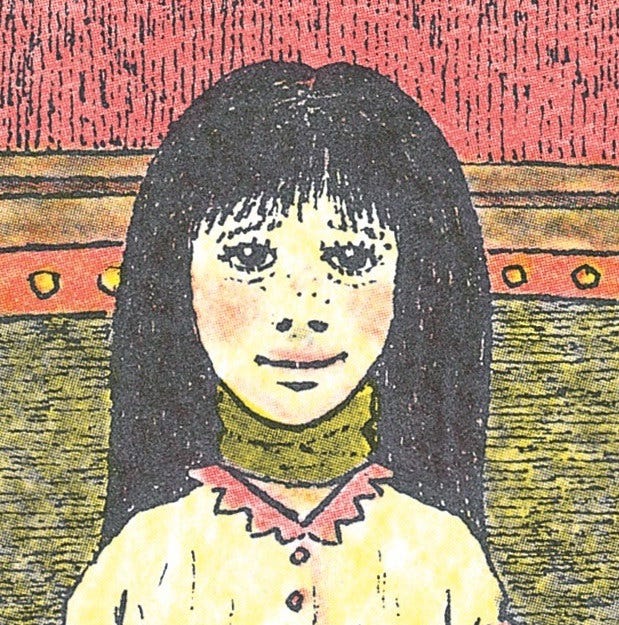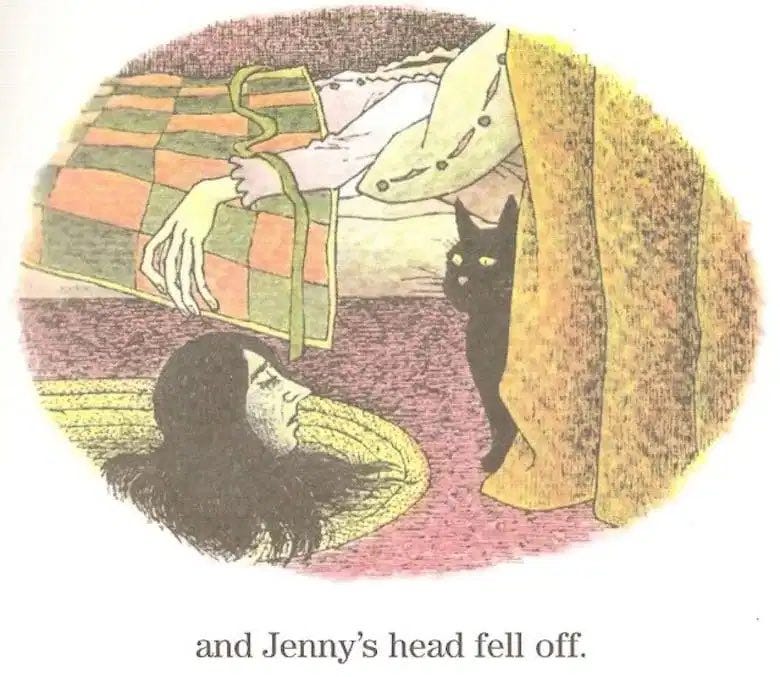Some of you creepy kids will remember reading In a Dark, Dark Room growing up, and the story of Jenny and her green ribbon.
The story is simple:
Jenny meets a boy named Alfred.
Alfred asks Jenny why she’s always wearing a green ribbon.
Jenny tells him he has to wait to find out.
The two eventually get married, but Jenny still won’t take off the ribbon.
Finally, when Jenny is sick and dying, she tells Alfred she’ll explain why she wore the green ribbon after he removes it.
After YEARS of waiting, Alfred unties the ribbon, and Jenny’s severed head falls to the ground.
If you’re anything like me, this story probably stuck with you for a variety of reasons, chief among them the haunting illustrations:
Jenny or the girl from the Ring? (In a Dark, Dark Room and Other Scary Stories by Alvin Schwartz and illustrator Dirk Zimmer)
The cat is my favorite character (In a Dark, Dark Room and Other Scary Stories by Alvin Schwartz and illustrator Dirk Zimmer)
But, did you know that Jenny’s tale actually dates back to 17th-century France? Original versions of the story involve demonic possession, necrophilia, adultery, insanity, and our good friend, the guillotine.
The story we now know was popularized by Washington Irving, who penned a little story you might know called The Legend of Sleepy Hollow. In his collection of short stories, Tales of a Traveller, the main character heads to France after a mental breakdown, only to find the French Revolution in full swing (this does not help).
One night he meets a beautiful woman with a velvet ribbon on her neck, crouched beside a guillotine. He decides the best thing to do is get to know her, and the two hit it off instantly. They head back to his apartment, fall in love, and according to the narrator, spend the night “swearing their eternal love” (they had sex).
The young traveler wakes up and decides to take himself for a morning stroll and let his new lady friend sleep in. Upon his return, the young man finds the police and one very decapitated soulmate. It turns out the love of his life was actually beheaded the night before and he may or may not have spent the evening “swearing eternal love” to a corpse. As you can imagine, this was not good news for the man’s mental health (or the world tour).
Convinced the only reasonable explanation for this was that a demon possessed and reanimated the dead woman’s body to mess with him, our young narrator takes a rather permanent vacation to an asylum.
But, Irving wasn’t the only writer intrigued by the ribbon story…
Irving actually based his story on Sir Guy Eveling’s Dream, which was written by his friend, Irish writer Thomas Moore. Don’t worry, though; Irving didn’t steal the story. During a visit, Moore recounted the story to Irving, as he felt it would be a good addition to his ghost stories, and Irving went to town.
Moore’s story is similar to Irving’s, though the twist was not the guillotine. In his retelling, when the necklace is removed, it reveals a violently bruised neck. It turns out the love of this man’s life was a recently hung window, who’d been found guilty of murdering her husband. Yes, it was still a dead woman, but at least she still had a head, right?
Scholars believe Moore might have been inspired by a 1613 French pamphlet about why necrophilia was bad news bears. The pamphlet contained a similar story where a man thought he was making love to a beautiful woman, but it turned out the devil had reanimated her corpse and tricked him.
This obviously begs the question of what was going on in France that a pamphlet needed to be distributed to discourage necrophilia, but I digress…
Both Alexandre Dumas and Gaston Leroux, authors of The Count of Monte Cristo and Phantom of the Opera respectively, also threw their hat into the ring with their own takes on the ribbon story.
Leroux’s story, The Woman with a Velvet Collar, is a tale within a tale. It begins with a sailor recounting a ghost story for his friend about a headless woman that still lives. The sailor tells the story of a French Revolution themed ball (surely not in poor taste), where a husband decides to take revenge on his adulterous wife.
You see, it turns out the wife has been sleeping with one of his staff members, who also turns out to be her cousin (though that doesn’t seem to be as big an issue). He concocts an idea for a little skit involving a “fake” guillotine and convinces his wife to dress up as Marie Antoinette and participate. Unfortunately, for the wife, the guillotine is very real, but unfortunately, for the husband, losing her head doesn’t quite do the trick.
Dumas’ story, The Woman with the Velvet Necklace, perhaps my favorite, is similar to Irving and Moore’s stories, but randomly makes author Ernst Theodor Wilhelm Hoffmann (who wrote the short story The Nutcracker Ballet is based) a main character.
This story is absolutely balls to the wall, and involves the public execution of Madame du Barry (King Louis XV’s mistress), a mysterious doctor who hangs out in theaters, the main character deciding to buy a ballerina he’s obsessed with, and a velvet ribbon with a guillotine charm. It has everything, and of course, ends with the main character, who I would like to remind you was a very real person who thankfully did not live long enough to see himself become a necrophiliac in print, finding out he’d spent the night with a very dead ballerina.
Who would have known Jenny had such a colorful, necrophilia-filled past?
It’s not surprising that a story that’s stayed with many of us throughout the years has captured the attention of writers for centuries. Authors are still telling versions of this story today, like Carmen Maria Machado in her amazing short story, The Husband Stitch.
And while the story was creepy enough to read as a child, there are many reasons it still lingers on the periphery of our minds today. Do we ever really know who we are bringing home? Do we overlook things about people that could put us in danger? And can we tell the difference between a living person and a dead one?
I hope you enjoyed our brief sojourn into a dark, dark room, and found a few new scary stories to read in the dark!
Reading List:
In a Dark, Dark Room and Other Scary Stories by Alvin Schwartz
Sir Guy Eveling’s Dream by Thomas Moore
Tales of a Traveller by Washington Irving
The Husband Stitch by Carmen Maria Machado
The Woman with a Velvet Collar by Gaston Leroux
The Woman with the Velvet Necklace by Alexandre Dumas



